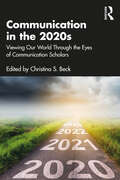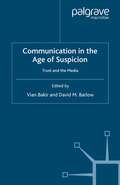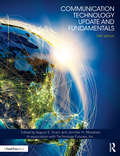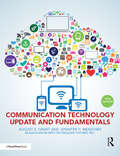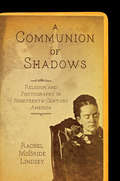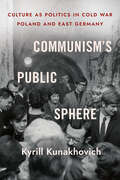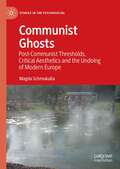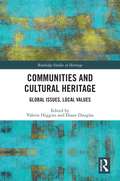- Table View
- List View
Communication in the 2020s: Viewing Our World Through the Eyes of Communication Scholars
by Christina S. BeckThis book provides an inside look at the discipline of Communication. In this collection of chapters, top scholars from a wide range of subfields discuss how they have experienced and how they study the crucial issues of our time. The 2020s opened with a series of events with massive implications for the ways we communicate, from the COVID-19 pandemic, a summer of protests for social justice, and climate change-related natural disasters, to one of the most contentious presidential elections in modern U.S. history. The chapters in this book provide snapshots of many of these issues as seen through the eyes of specialists in the major subfields of Communication, including interpersonal, organizational, strategic, environmental, religious, social justice, risk, sport, health, family, instructional, and political communication. Written in an informal style that blends personal narrative with accessible explanation of basic concepts, the book is ideal for introducing students to the range and practical applications of Communication discipline. This book comprises a valuable companion text for Introduction to Communication courses as well as a primary resource for Capstone and Introduction to Graduate Studies courses. Further, this collection provides meaningful insights for Communication scholars as we look ahead to the remainder of the 2020s and beyond.
Communication in the 2020s: Viewing Our World Through the Eyes of Communication Scholars
by Christina S. BeckThis book provides an inside look at the discipline of Communication. In this collection of chapters, top scholars from a wide range of subfields discuss how they have experienced and how they study the crucial issues of our time. The 2020s opened with a series of events with massive implications for the ways we communicate, from the COVID-19 pandemic, a summer of protests for social justice, and climate change-related natural disasters, to one of the most contentious presidential elections in modern U.S. history. The chapters in this book provide snapshots of many of these issues as seen through the eyes of specialists in the major subfields of Communication, including interpersonal, organizational, strategic, environmental, religious, social justice, risk, sport, health, family, instructional, and political communication. Written in an informal style that blends personal narrative with accessible explanation of basic concepts, the book is ideal for introducing students to the range and practical applications of Communication discipline. This book comprises a valuable companion text for Introduction to Communication courses as well as a primary resource for Capstone and Introduction to Graduate Studies courses. Further, this collection provides meaningful insights for Communication scholars as we look ahead to the remainder of the 2020s and beyond.
Communication in the Age of Suspicion: Trust and the Media
by V. Bakir D. BarlowIn this timely volume, fourteen international contributors explore the relationship between media and trust, beginning with an examination of the decline of trust in key institutions. The book concludes by considering the future implications for media communication and exploring potential directions for further research in this Age of Suspicion.
Communication in the Design Process
by Stephen A. BrownThe Design and Construction industry is in a state of attempted change. Improvement is a key word for employer, consultant and contractor. Real steps forward are slow, and most damning is the continuous repetition of the same mistakes. Communication in the Design Process considers the gap that can exist between client expectation and realisation in building projects. It focuses on the communication interface between the employer and the consultant design team, and specifically on the areas of function, finance, timescale and aesthetics. This book includes an extensive review of current thinking and guidance on this and other related subjects. New data is obtained from a survey using questionnaires and personal semi-structured interviews. Data is presented graphically, analysed and compared with practice as defined in current literature.
Communication in the Design Process
by Stephen A. BrownThe Design and Construction industry is in a state of attempted change. Improvement is a key word for employer, consultant and contractor. Real steps forward are slow, and most damning is the continuous repetition of the same mistakes. Communication in the Design Process considers the gap that can exist between client expectation and realisation in building projects. It focuses on the communication interface between the employer and the consultant design team, and specifically on the areas of function, finance, timescale and aesthetics. This book includes an extensive review of current thinking and guidance on this and other related subjects. New data is obtained from a survey using questionnaires and personal semi-structured interviews. Data is presented graphically, analysed and compared with practice as defined in current literature.
Communication Technology Update and Fundamentals: 16th Edition
by August E. Grant Jennifer H. MeadowsFor three decades, Communication Technology Update and Fundamentals has set the standard as the single best resource for students and professionals looking to brush up on how communication technologies have developed, grown, and converged, as well as what’s in store for the future. The secret to the longevity is simple—every two years, the book is completely rewritten to ensure that it contains the latest developments in mass media, computers, consumer electronics, networking, and telephony. Plus, the book includes the Fundamentals: the first five chapters explain the communication technology ecosystem, the history, structure, and regulations. The chapters are written by experts who provide snapshots of the state of each individual field. Together, these updates provide a broad overview of these industries, as well as the role communication technologies play in our everyday lives. In addition to substantial updates to each chapter, the 16th edition includes: First-ever chapters on Virtual/Augmented Reality and eSports. Updated user data in every chapter. Overview of industry structure, including recent and proposed mergers and acquisitions Suggestions on how to get a job working with the technologies discussed. The companion website, www.tfi.com/ctu, offers updated information on the technologies covered in this text, as well as links to other resources.
Communication Technology Update and Fundamentals: 15th Edition
by August E. Grant Jennifer H. MeadowsCommunication Technology Update and Fundamentals has set the standard as the single best resource for students and professionals looking to brush up on how communication technologies have developed, grown, and converged, as well as what’s in store for the future. The 15th edition is completely updated, reflecting the changes that have swept the communication industries. The first five chapters offer the communication technology fundamentals, including the ecosystem, the history, and structure—then delves into each of about two dozen technologies, including mass media, computers, consumer electronics, and networking technologies. Each chapter is written by experts who provide snapshots of the state of each individual field. Together, these updates provide a broad overview of these industries, as well as the role communication technologies play in our everyday lives. In addition to substantial updates to each chapter, the 15th edition includes: First-ever chapters on Big Data and the Internet of Things Updated user data in every chapter Projections of what each technology will become by 2031 Suggestions on how to get a job working with the technologies discussed The companion website, www.tfi.com/ctu, offers updated information on the technologies covered in this text, as well as links to other resources
Communication Technology Update and Fundamentals: 15th Edition
by August E. Grant Jennifer H. MeadowsCommunication Technology Update and Fundamentals has set the standard as the single best resource for students and professionals looking to brush up on how communication technologies have developed, grown, and converged, as well as what’s in store for the future. The 15th edition is completely updated, reflecting the changes that have swept the communication industries. The first five chapters offer the communication technology fundamentals, including the ecosystem, the history, and structure—then delves into each of about two dozen technologies, including mass media, computers, consumer electronics, and networking technologies. Each chapter is written by experts who provide snapshots of the state of each individual field. Together, these updates provide a broad overview of these industries, as well as the role communication technologies play in our everyday lives. In addition to substantial updates to each chapter, the 15th edition includes: First-ever chapters on Big Data and the Internet of Things Updated user data in every chapter Projections of what each technology will become by 2031 Suggestions on how to get a job working with the technologies discussed The companion website, www.tfi.com/ctu, offers updated information on the technologies covered in this text, as well as links to other resources
Communication Technology Update and Fundamentals: 16th Edition
by August E. Grant Jennifer H. MeadowsFor three decades, Communication Technology Update and Fundamentals has set the standard as the single best resource for students and professionals looking to brush up on how communication technologies have developed, grown, and converged, as well as what’s in store for the future. The secret to the longevity is simple—every two years, the book is completely rewritten to ensure that it contains the latest developments in mass media, computers, consumer electronics, networking, and telephony. Plus, the book includes the Fundamentals: the first five chapters explain the communication technology ecosystem, the history, structure, and regulations. The chapters are written by experts who provide snapshots of the state of each individual field. Together, these updates provide a broad overview of these industries, as well as the role communication technologies play in our everyday lives. In addition to substantial updates to each chapter, the 16th edition includes: First-ever chapters on Virtual/Augmented Reality and eSports. Updated user data in every chapter. Overview of industry structure, including recent and proposed mergers and acquisitions Suggestions on how to get a job working with the technologies discussed. The companion website, www.tfi.com/ctu, offers updated information on the technologies covered in this text, as well as links to other resources.
Communication Technology Update and Fundamentals: 17th Edition
by August E. Grant Jennifer H. MeadowsCommunication Technology Update and Fundamentals, now in its 17th edition, has set the standard as the single best resource for students and professionals looking to brush up on how communication technologies have developed, grown, and converged, as well as what’s in store for the future. The book covers the fundamentals of communication technology in five chapters that explain the communication technology ecosystem, its history, theories, structure, and regulations. Each chapter is written by experts who each provide a snapshot of an individual field. The book also dives into the latest developments in electronic mass media, computers, consumer electronics, networking, and telephony. Together, these updates provide a broad overview of these industries and examine the role communication technologies play in our everyday lives. In addition to substantial updates to each chapter, the 17th edition includes the first-ever chapter on Artificial Intelligence; updated user data in every chapter; an overview of industry structure, including recent and proposed mergers and acquisitions; and sidebars exploring sustainability and relevance of each technology to Gen Z. Communication Technology Update and Fundamentals continues to be the industry-leading resource for both students and professionals seeking to understand how communication technologies have developed and where they are headed.
Communication Technology Update and Fundamentals: 17th Edition
by August E. Grant Jennifer H. Meadows Technology Futures Inc.Communication Technology Update and Fundamentals, now in its 17th edition, has set the standard as the single best resource for students and professionals looking to brush up on how communication technologies have developed, grown, and converged, as well as what’s in store for the future. The book covers the fundamentals of communication technology in five chapters that explain the communication technology ecosystem, its history, theories, structure, and regulations. Each chapter is written by experts who each provide a snapshot of an individual field. The book also dives into the latest developments in electronic mass media, computers, consumer electronics, networking, and telephony. Together, these updates provide a broad overview of these industries and examine the role communication technologies play in our everyday lives. In addition to substantial updates to each chapter, the 17th edition includes the first-ever chapter on Artificial Intelligence; updated user data in every chapter; an overview of industry structure, including recent and proposed mergers and acquisitions; and sidebars exploring sustainability and relevance of each technology to Gen Z. Communication Technology Update and Fundamentals continues to be the industry-leading resource for both students and professionals seeking to understand how communication technologies have developed and where they are headed.
Communications Systems: Engineers' Choices (Routledge Library Editions: Broadcasting #18)
by Geoff LewisCommunications Systems (1999) examines various communications systems using satellites, and includes much information on coding and modulation systems such as MOBIC, digital SNG systems, mobile phones, MPEG, MPEG4 capabilities and Hypermedia, the Grand Alliance TV systems, MUSE and how it is used in Japan, the European and North American Digital Video Broadcasting Systems, MMDS and Digital Audio Broadcasting. It explores the rapid convergence occurring between satellite and terrestrial services. It provides a solid base of principles, including mathematics where necessary, to explain the developments which have taken place within these industries.
Communications Systems: Engineers' Choices (Routledge Library Editions: Broadcasting #18)
by Geoff LewisCommunications Systems (1999) examines various communications systems using satellites, and includes much information on coding and modulation systems such as MOBIC, digital SNG systems, mobile phones, MPEG, MPEG4 capabilities and Hypermedia, the Grand Alliance TV systems, MUSE and how it is used in Japan, the European and North American Digital Video Broadcasting Systems, MMDS and Digital Audio Broadcasting. It explores the rapid convergence occurring between satellite and terrestrial services. It provides a solid base of principles, including mathematics where necessary, to explain the developments which have taken place within these industries.
Communications Writing and Design: The Integrated Manual for Marketing, Advertising, and Public Relations
by John DiMarcoCommunications Writing and Design is an integrated, project-based introduction to effective writing and design across the persuasive domains of communication. Build a strong foundation of core writing and design skills using professionally-designed examples that illustrate and reinforce key principles Readers learn and analyze techniques by creating 15 projects in marketing, advertising, PR, and social media with the help of strategy suggestions, practical tips, and professional production techniques Written by an experienced professional and teacher, with a focus on the cross-disciplinary nature of contemporary communication work Learning is reinforced through a variety of pedagogical features: learning objectives, helpful mnemonics, real-life projects and applications, chapter references for further study, and end-of-chapter summaries and exercises A companion website with multimedia slides, exam questions, learning videos, and design guides provides additional learning tools for students and instructors
Communications Writing and Design: The Integrated Manual for Marketing, Advertising, and Public Relations
by John DiMarcoCommunications Writing and Design is an integrated, project-based introduction to effective writing and design across the persuasive domains of communication. Build a strong foundation of core writing and design skills using professionally-designed examples that illustrate and reinforce key principles Readers learn and analyze techniques by creating 15 projects in marketing, advertising, PR, and social media with the help of strategy suggestions, practical tips, and professional production techniques Written by an experienced professional and teacher, with a focus on the cross-disciplinary nature of contemporary communication work Learning is reinforced through a variety of pedagogical features: learning objectives, helpful mnemonics, real-life projects and applications, chapter references for further study, and end-of-chapter summaries and exercises A companion website with multimedia slides, exam questions, learning videos, and design guides provides additional learning tools for students and instructors
Communicology: Mutations in Human Relations? (Sensing Media: Aesthetics, Philosophy, and Cultures of Media)
by Vilém FlusserCommunicology is Vilém Flusser's first thesis on his concepts of technical images and technical imagination. In this foundational text he lays the groundwork for later work, offering a philosophical approach to communication as a phenomenon that permeates every aspect of human existence. Clearly organized around questions such as "What is Communication?," "What are Codes?," and "What is Technical Imagination?," the work touches on theater, photography, film, television, and more. Originally written in 1978, but only posthumously published in German, the book is one of the clearest statements of Flusser's theory of communication as involving a variably mediated relation between humans and the world. Although Flusser was writing in the 1970s, his work demonstrates a prescience that makes it of significant contemporary interest to scholars in visual culture, art history, media studies, and philosophy.
Communicology: Mutations in Human Relations? (Sensing Media: Aesthetics, Philosophy, and Cultures of Media)
by Vilém FlusserCommunicology is Vilém Flusser's first thesis on his concepts of technical images and technical imagination. In this foundational text he lays the groundwork for later work, offering a philosophical approach to communication as a phenomenon that permeates every aspect of human existence. Clearly organized around questions such as "What is Communication?," "What are Codes?," and "What is Technical Imagination?," the work touches on theater, photography, film, television, and more. Originally written in 1978, but only posthumously published in German, the book is one of the clearest statements of Flusser's theory of communication as involving a variably mediated relation between humans and the world. Although Flusser was writing in the 1970s, his work demonstrates a prescience that makes it of significant contemporary interest to scholars in visual culture, art history, media studies, and philosophy.
A Communion of Shadows: Religion and Photography in Nineteenth-Century America
by Rachel McBride LindseyWhen the revolutionary technology of photography erupted in American culture in 1839, it swiftly became, in the day's parlance, a "mania." This richly illustrated book positions vernacular photography at the center of the study of nineteenth-century American religious life. As an empirical tool, photography captured many of the signal scenes of American life, from the gold rush to the bloody battlefields of the Civil War. But photographs did not simply display neutral records of people, places, and things; rather, commonplace photographs became inscribed with spiritual meaning, disclosing, not merely signifying, a power that lay beyond.Rachel McBride Lindsey demonstrates that what people beheld when they looked at a photograph had as much to do with what lay outside the frame--theological expectations, for example--as with what the camera had recorded. Whether studio portraits tucked into Bibles, postmortem portraits with locks of hair attached, "spirit" photography, stereographs of the Holy Land, or magic lanterns used in biblical instruction, photographs were curated, beheld, displayed, and valued as physical artifacts that functioned both as relics and as icons of religious practice. Lindsey's interpretation of "vernacular" as an analytic introduces a way to consider anew the cultural, social, and material reach of religion.A multimedia collaboration with MAVCOR—Center for the Study of Material & Visual Cultures of Religion—at Yale University.
Communism's Public Sphere: Culture as Politics in Cold War Poland and East Germany
by Kyrill KunakhovichCommunism's Public Sphere explores the political role of cultural spaces in the Eastern Bloc. Under communist regimes that banned free speech, political discussions shifted to spaces of art: theaters, galleries, concert halls, and youth clubs. Kyrill Kunakhovich shows how these venues turned into sites of dialogue and contestation. While officials used them to spread the communist message, artists and audiences often flouted state policy and championed alternative visions. Cultural spaces therefore came to function as a public sphere, or a rare outlet for discussing public affairs.Focusing on Kraków in Poland and Leipzig in East Germany, Communism's Public Sphere sheds new light on state-society interactions in the Eastern Bloc. In place of the familiar trope of domination and resistance, it highlights unexpected symbioses like state-sponsored rock and roll, socialist consumerism, and sanctioned dissent. By examining nearly five decades of communist rule, from the Red Army's arrival in Poland in 1944 to German reunification in 1990, Kunakhovich argues that cultural spaces played a pivotal mediating role. They helped reform and stabilize East European communism but also gave cover to the protest movements that ultimately brought it down.
Communist Ghosts: Post-Communist Thresholds, Critical Aesthetics and the Undoing of Modern Europe (Studies in the Psychosocial)
by Magda SchmukallaThis book explores post-communist thresholds as materializations of a specific crisis of modern European identity that was caused by the existence and sudden breakdown of Soviet-type communism. It shows how post-communist thresholds emerge where relics from the communist experience continue disrupting the routines and rhythms of a modern life and confront Europeans with cultural experiences, affects and material realities of the ‘enlightened world’ which they usually seek to repress or ignore. In exploring and writing through art projects which engage with the psychosocial fabric of such post-communist thresholds, this book finds ways of speaking and thinking through these transitory and paradox sites, and asks what we can say about other or new worlds, about new beginnings and endings as well as about decolonial and ethical ways of relating to the other when assessing the status quo of European modernity from within its liminal and crisis-driven sphere.
Communities and Cultural Heritage: Global Issues, Local Values
by Valerie HigginsCommunities and Cultural Heritage explores the relationship between communities, their cultural heritage and the global forces that control most of the world’s wealth and resources in today’s world. Bringing together scholars and heritage practitioners from nine countries, this book contributes to the ongoing dialogue on community heritage by analysing impediments to full community participation. The underminin of local communities comes at a high price. As the chapters in this book demonstrate, the knowledge embedded within traditional and Indigenous heritage creates communities that are more resilient to environmental and social stressors and more responsive to contemporary challenges such as climate change, environmental degradation, post-disaster recovery and relocation. Cultural heritage practices often fail to capitalise upon local knowledge and traditional skills and undervalue the potential contribution of local communities in finding creative and resourceful solutions to the issues they are confronting. Arguing that the creation of successful community heritage project requires ongoing reflection on the aims, methods, financing and acceptable outcomes of projects, the volume also demonstrates that the decolonization of Western-focussed heritage practices is an ongoing process, by which subaltern groups are brought forward and given a space in the heritage narrative. Reflecting on trends that impact communities and heritage sites across different geographical regions, Communities and Cultural Heritage will be of interest to academics, students and practitioners of cultural heritage,archaeology and anthropology around the world.
Communities and Cultural Heritage: Global Issues, Local Values
by Valerie Higgins Diane DouglasCommunities and Cultural Heritage explores the relationship between communities, their cultural heritage and the global forces that control most of the world’s wealth and resources in today’s world. Bringing together scholars and heritage practitioners from nine countries, this book contributes to the ongoing dialogue on community heritage by analysing impediments to full community participation. The underminin of local communities comes at a high price. As the chapters in this book demonstrate, the knowledge embedded within traditional and Indigenous heritage creates communities that are more resilient to environmental and social stressors and more responsive to contemporary challenges such as climate change, environmental degradation, post-disaster recovery and relocation. Cultural heritage practices often fail to capitalise upon local knowledge and traditional skills and undervalue the potential contribution of local communities in finding creative and resourceful solutions to the issues they are confronting. Arguing that the creation of successful community heritage project requires ongoing reflection on the aims, methods, financing and acceptable outcomes of projects, the volume also demonstrates that the decolonization of Western-focussed heritage practices is an ongoing process, by which subaltern groups are brought forward and given a space in the heritage narrative. Reflecting on trends that impact communities and heritage sites across different geographical regions, Communities and Cultural Heritage will be of interest to academics, students and practitioners of cultural heritage,archaeology and anthropology around the world.
Communities and Museums in the 21st Century: Shared Histories and Climate Action (ICOM Advances in Museum Research)
by Karen BrownCommunities and Museums in the 21st Century brings together innovative, multidisciplinary perspectives on contemporary museology and participatory museum practice that contribute to wider debates on museum communities, heritage, and sustainability. Set within the context of globalisation and decolonisation, this book draws upon bi-regional research that will enrich our understanding of the complex relationships between Europe, Latin America and the Caribbean through museum studies and practice. Chapters reflect upon the role of museums in defining community identities; the importance of young people’s participation and intergenerational work for sustainability; the role of museums in local development; and community-based museums and climate change. Contributors examine these issues through the lens of museum partnerships and practices, as well as testing the continued relevance of the notion of ‘integral museum’ and its relatives in the form of ecomuseums. With its focus on regional museums in Latin America and Caribbean, this book highlights how the case studies promote greater intercultural dialogue, global understanding and social cohesion. It also demonstrates how the methodology can be adapted to other communities who are facing the perils of climate change and unsustainable forms of development. Communities and Museums in the 21st Century proposes creative and sustainable strategies relevant to a globalised future. With its focus on global societal challenges, this book will appeal to museologists and museum practitioners, as well as those working in heritage studies, cultural studies, memory studies, art history, gender studies, and sustainable development.
Communities and Museums in the 21st Century: Shared Histories and Climate Action (ICOM Advances in Museum Research)
Communities and Museums in the 21st Century brings together innovative, multidisciplinary perspectives on contemporary museology and participatory museum practice that contribute to wider debates on museum communities, heritage, and sustainability. Set within the context of globalisation and decolonisation, this book draws upon bi-regional research that will enrich our understanding of the complex relationships between Europe, Latin America and the Caribbean through museum studies and practice. Chapters reflect upon the role of museums in defining community identities; the importance of young people’s participation and intergenerational work for sustainability; the role of museums in local development; and community-based museums and climate change. Contributors examine these issues through the lens of museum partnerships and practices, as well as testing the continued relevance of the notion of ‘integral museum’ and its relatives in the form of ecomuseums. With its focus on regional museums in Latin America and Caribbean, this book highlights how the case studies promote greater intercultural dialogue, global understanding and social cohesion. It also demonstrates how the methodology can be adapted to other communities who are facing the perils of climate change and unsustainable forms of development. Communities and Museums in the 21st Century proposes creative and sustainable strategies relevant to a globalised future. With its focus on global societal challenges, this book will appeal to museologists and museum practitioners, as well as those working in heritage studies, cultural studies, memory studies, art history, gender studies, and sustainable development.
Communities of Practice: Art, Play, and Aesthetics in Early Childhood (Landscapes: the Arts, Aesthetics, and Education #21)
by Christopher M. Schulte Christine Marmé ThompsonReflecting contemporary theory and research in early art education, this volume offers a comprehensive introduction to new ways of thinking about the place of art, play, and aesthetics in the lives and education of young children. Enlivened by narratives and illustrations, 16 authors offer perspectives on the lived experience of being a child and discovering the excitement of making meaning and form in the process of art, play, and aesthetic inquiry.
